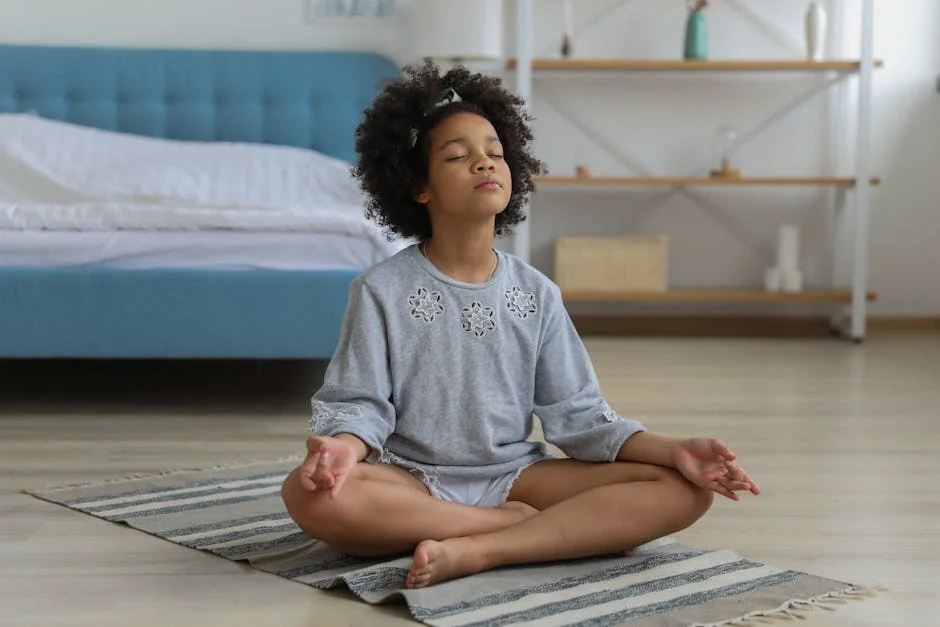Feeling overwhelmed, distracted, or like your mind is constantly running a marathon? You’re not alone. In the search for a moment of peace, the ancient practice of how to meditate for beginners at home offers a powerful and accessible refuge. Forget complex rituals or chanting for hours—meditation is simply the art of training your attention and awareness. And the best part? You don't need a special studio or any expensive equipment to get started. Your journey to greater calm, improved focus, and better sleep can begin right in your living room.
This guide is designed to demystify the process completely. We’ll walk you through creating a simple meditation space, finding a comfortable posture (no, you don't have to sit cross-legged!), and following a straightforward, 5-minute practice. Consider this your friendly, step-by-step roadmap to building a sustainable habit that fits seamlessly into your life at home. Let's begin.
Preparing Your Space and Mind
Before you begin, a little preparation makes learning how to meditate at home much smoother. You don't need a dedicated room; a small, consistent corner is perfect.
- Choose Your Spot: Find a relatively quiet space where you can sit undisturbed. This could be a corner of your bedroom or a quiet chair in the living room.
- Minimize Distractions: Silence your phone or put it in another room. If you live with others, a simple heads-up can prevent interruptions.
- Start Small: Aim for just 5-10 minutes. It’s more sustainable for a beginner than aiming for a longer session and getting discouraged.
- Pick a Time: Many find morning meditation sets a calm tone for the day, while evening practice can help unwind. Consistency matters more than the specific time.
A Simple Posture for Effective Meditation
The goal is to be both alert and relaxed. You can meditate in a chair or on the floor.
Seated in a Chair
Sit upright with your feet flat on the floor. Rest your hands on your knees or comfortably in your lap. Avoid leaning against the chair's back if you can, to stay alert.
Seated on the Floor
Sit on a cushion to elevate your hips slightly above your knees. This helps keep your spine straight naturally. You can sit cross-legged or in a kneeling position.
The key is an upright spine—imagine a string pulling the crown of your head gently toward the ceiling. This posture helps you stay focused and prevents drowsiness.
Your First 5-Minute Meditation Practice
Ready to try? This simple breath-focused meditation is your foundation. If you're looking for more detailed guidance on the process, our guide on how to actually meditate breaks it down step-by-step.
- Step 1: Set a gentle timer for 5 minutes.
- Step 2: Sit in your chosen posture and gently close your eyes.
- Step 3: Bring your attention to your natural breath. Don’t force it to be deeper or slower; just feel the sensation of the air moving in and out.
- Step 4: Pick a single anchor point, like the feeling of your breath at your nostrils or the rise and fall of your belly.
- Step 5: Your mind will wander. This is completely normal and the most important part of the practice! When you notice your thoughts have drifted, gently and kindly guide your attention back to your breath. Each return is a rep for your focus muscle.
- Step 6: When the timer sounds, slowly open your eyes. Take a moment to notice how your body and mind feel before you get up.
Common Beginner Challenges and Solutions
Every meditator faces these hurdles. Knowing what to expect is half the battle.
- "I can't stop my thoughts." The goal of meditation is not to empty your mind, but to become more aware of your thoughts without getting lost in them. The simple act of noticing your mind has wandered and returning to your breath is the practice.
- "I get too restless or fidgety." A little physical discomfort is normal. If it becomes sharp or painful, feel free to adjust your position mindfully. Acknowledge the itch or ache, then see if you can return your focus to the breath for a few more moments before moving.
- "I fall asleep." This often happens if you're tired or meditating in a reclined position. Try sitting more upright with your spine straight, or practice at a time of day when you feel more alert.
Embarking on a meditation practice at home is a powerful step toward greater mental clarity and emotional balance. As we have explored, the journey begins with simplicity: find a quiet space, commit to a short, consistent time each day, and focus on the natural rhythm of your breath. Remember that a wandering mind is not a failure but a fundamental part of the process; the simple act of gently returning your attention to your anchor is the practice itself. Start with just five to ten minutes to build a sustainable habit without feeling overwhelmed. The true essence of meditation lies not in emptying your mind, but in cultivating a gentle awareness of your present-moment experience. For those seeking a deeper purpose behind the practice, you can explore how to meditate a guide to self-discovery. This consistent practice, even in small doses, can significantly reduce daily stress and enhance your overall sense of well-being. If you are specifically using meditation to manage difficult emotions, our article on how to meditate for depression and anxiety offers targeted techniques. Be patient and compassionate with yourself as you develop this new skill. Your journey inward awaits—take a deep breath, begin today, and discover the profound peace that has been within you all along.



